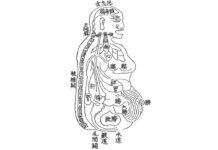By Simon Kim, Professor, South Baylo University
Last month, I contended that there is a certain commonality between the cosmology of the philosophy of organism and the Qi philosophy: the union of Heaven and Human (天人合一). Comparing with macroscopic cosmology, the Yinyang theory is a sort of microscopic theme in the interpretation of nature. However, without this basic concept of the qi philosophy, we cannot capture any phenomena in the whole universe. From the matter, virus and to the human body, there is nothing that cannot be seen through the Yinyang structure. As you know, the concept of Yinyang is the most pervasive idea in the East Asian medicine.
In the organismic Qi world, the relationship of Yin qi and Yang qi looks like two poles of one world. I already introduced the concept of reciprocity in the section of the Yinyang theory. Reciprocity (待對) means that one thing is given or done or owed to each other. The Taiji diagram expresses the reciprocity logic exactly. The Yinyang reciprocity is a way of thinking that carries time and mobility in the process of qi realization. When I defined the concept of Yin and Yang, I called the organic synthesis of Yin qi and Yang qi as the reciprocity of qi organism.
As Richard Rorty (1931-1998) spotlighted the anti-reductionistic features of Whitehead’s cosmology, he unwittingly verified the reciprocity logic of the philosophy of organism. (‘Matter and Event’ from The Concept of Matter in Modern Philosophy, edited by Ernan McMullin, 1963) According to his analysis of Whiteheadian realism, distinctions of Actual Entity and Actual Occasion – a basic concept of the philosophy of organism – are attempts to locate ultimate and irreducible categoreal distinctions. Rorty argued for the correlative relation of AE and AO that something can only sustain external relations if it also sustains internal relations, or the converse, or both.
Some prominent philosophers who can interpret Whitehead’s metaphysical theory of organism tend to define AE as Yin qi and AO as Yang qi. “While the Yinqi from inside serves to hold the active Yangqi, the Yangqi which exists outside vitalizes the inner Yinqi. (陰在內 陽之守也 陽在外 陰之使也: 內經 素問)” Whitehead holds that an AE cannot be analyzed without remainder either into its physical prehensions of other AE. (PR, 134). Nor can these two poles be disjoined in order to be interpreted as two independent AEs in their own right. Likewise the relationship of Yin and Yang, an actual entity can retain its integrity only by being interpreted in terms of both levels of entities.
The philosophy of organism shows apparently a reciprocal and correlative logic which can be applied to both Yinqi /Yangqi and AE/AO. According to Rorty’s interpretation, each level of AE/AO must be essentially incomplete, and completable only by interpretation in terms of the other level. As such, two philosophies, the Qi philosophy and the philosophy of organism, inevitably used the reciprocity logic of yin and yang because of the common view that all beings in nature are interconnected.








































